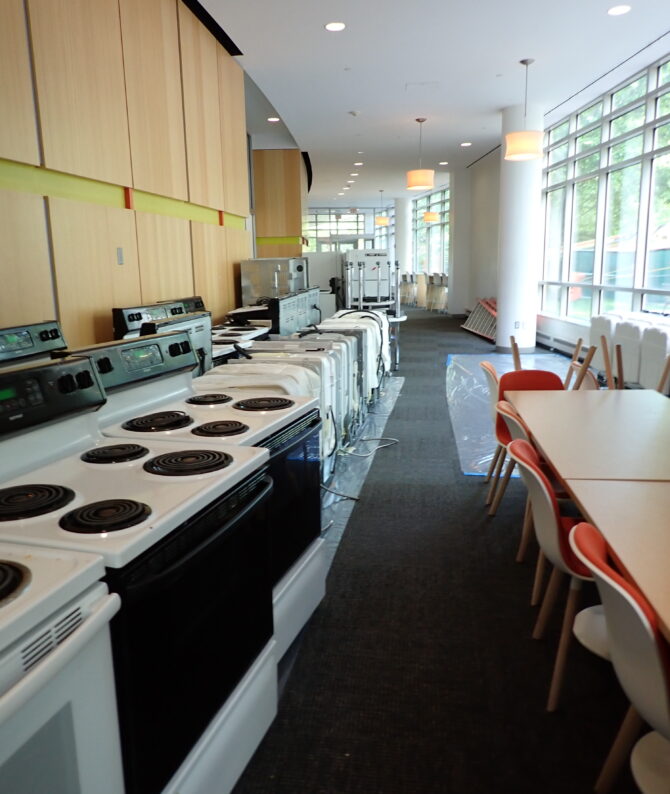Automation and Analytics: Silent Sustainability Tools

You might never know it’s happening, but in buildings all across Northeastern’s campus, computer hardware and software are automating heating and cooling systems and building analytics are monitoring them. Joe Ranahan, Director of Energy for Northeastern’s Boston campus, describes building analytics as “using a computer to watch a computer.”
The first computer in this scenario is the automation system, which basically just means the building controls. A simple example would be a thermostat which senses the temperature and turns the heating system on/off. Building automation takes in data from many sources, makes decisions based on that data, and sends commands to mechanical systems. The second computer is building analytics – the process of monitoring the automation system to find problems so you can quickly diagnose issues in the building.
“There’s a constant data stream from the automation system back to a server,” Ranahan said. “The analytics platform just reads those data points and sends that data up to the cloud, where it’s compared against mathematical models of the building when it is working properly.”
Before analytics, buildings would “drift” as temperature and other sensors lost their calibration or mechanical systems wear out, and the building can develop problems. The automation system can withstand and even overcome a small set of problems, but this typically comes with the cost of higher energy consumption. Eventually, the problems overcome the ability of the automation system to keep the building warm or cool and a disrupting and expensive project has to be planned to solve the issue. Analytics allow for the constant monitoring of buildings so things can be fixed as they break. This saves energy and spreads repair costs out evenly over time.
When new buildings are completed, systems are compared to their design to make sure they’re running as intended; this is called commissioning. Re-commissioning is taking stock of an old building, checking to see if it’s running as it did when it was new, and making repairs as they are found. Building analytics allow for “continuous commissioning” – constantly checking to make sure the building is running as efficiently as it should. “Instead of letting a building fade, letting a building go from good to bad and then fixing it when it’s bad, you’re always fixing little pieces and keeping it as close to its original state as you can,” Ranahan said.
Even in older buildings, humans aren’t always the best at making sure problems get fixed promptly. “It can take a long time for someone to recognize that it’s not working properly,” Ranahan said about heating and cooling systems. “An occupant may just say ‘oh, my office is always hot’ or ‘my office is always cold,’ but they don’t think to put in a work order to call attention to the problem and we would just fix it. But it’s just the nature of people sometimes to accept the conditions they get used to.”
While analytics can detect problems that humans might not otherwise notice, automation can connect different systems together through a process called integration.
In many Northeastern classrooms, labs, and office spaces, there are occupancy sensors which control the lights. If nobody is in the room for long enough, the lights will automatically shut off. Through the automation system, the sensors can connect to the heating and cooling, allowing the facilities team to “float the temperature.” Basically, if no one is in a space, they have a “secondary temperature” that they allow the room to reach. In the summer that would be a little warmer and, in the winter, a little cooler. Integration is becoming a big part of buildings, and it’s becoming more advanced. “Eventually your refrigerator is going to talk to your stove,” Ranahan said.
Despite the obvious benefits of automation and analytics, they’re not magic. The analytics don’t tell you if something specific is broken, it just tells you that there’s a problem. In this case, the building is like a sick patient, and the analytics are revealing symptoms. You still need a doctor to diagnose and treat the problem.
At the end of the day, building automation and analytics are best thought of as useful tools in the arsenal of those who maintain buildings and the systems within them. They can reveal problems that humans don’t notice or don’t care enough to mention. They also allow buildings to be seamlessly more efficient and sustainable, which is more important than ever as climate change continues.
Written by Adam Doucette – 4/15/2022



